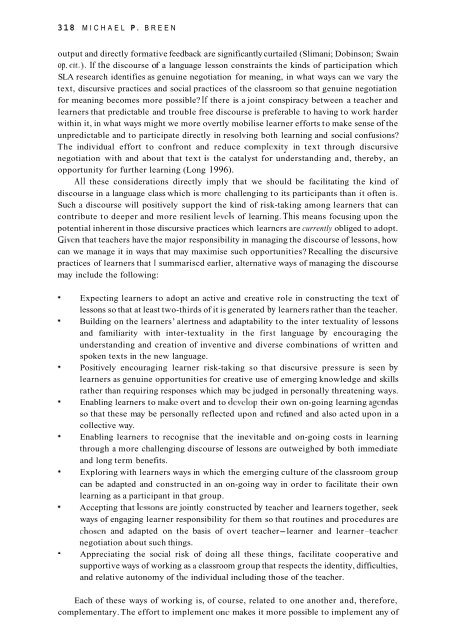English Language Teaching in its Social Context
English Language Teaching in its Social Context
English Language Teaching in its Social Context
Create successful ePaper yourself
Turn your PDF publications into a flip-book with our unique Google optimized e-Paper software.
318 MICHAEL P. BREENoutput and directly formative feedback are significantly curtailed (Slimani; Dob<strong>in</strong>son; Swa<strong>in</strong>op. ut.). If the discourse of a language lesson constra<strong>in</strong>ts the k<strong>in</strong>ds of participation whichSLA research identifies as genu<strong>in</strong>e negotiation for mean<strong>in</strong>g, <strong>in</strong> what ways can we vary thetext, discursive practices and social practices of the classroom so that genu<strong>in</strong>e negotiationfor mean<strong>in</strong>g becomes more possible? If there is a jo<strong>in</strong>t conspiracy between a teacher andlearners that predictable and trouble free discourse is preferable to hav<strong>in</strong>g to work harderwith<strong>in</strong> it, <strong>in</strong> what ways might we more overtly mobilise learner efforts to make sense of theunpredictable and to participate directly <strong>in</strong> resolv<strong>in</strong>g both learn<strong>in</strong>g and social confusions?The <strong>in</strong>dividual effort to confront and reduce complcxity <strong>in</strong> text through discursivenegotiation with and about that text is the catalyst for understand<strong>in</strong>g and, thereby, anopportunity for further learn<strong>in</strong>g (Long 1996).All these considerations directly imply that we should be facilitat<strong>in</strong>g the k<strong>in</strong>d ofdiscourse <strong>in</strong> a language class which is more challeng<strong>in</strong>g to <strong>its</strong> participants than it often is.Such a discourse will positively support the k<strong>in</strong>d of risk-tak<strong>in</strong>g among learners that cancontribute to deeper and more resilient level5 of learn<strong>in</strong>g. This means focus<strong>in</strong>g upon thepotential <strong>in</strong>herent <strong>in</strong> those discursive practices which learncrs are currently obliged to adopt.Given that teachers have the major responsibility <strong>in</strong> manag<strong>in</strong>g the discourse of lessons, howcan we manage it <strong>in</strong> ways that may maximise such opportunities? Recall<strong>in</strong>g the discursivepractices of learners that I summariscd earlier, alternative ways of manag<strong>in</strong>g the discoursemay <strong>in</strong>clude the follow<strong>in</strong>g:Expect<strong>in</strong>g learners to adopt an active and creative role <strong>in</strong> construct<strong>in</strong>g the tcxt oflessons so that at least two-thirds of it is generated by learners rather than the teacher.Build<strong>in</strong>g on the learners’ alertness and adaptability to the <strong>in</strong>ter textuality of lessonsand familiarity with <strong>in</strong>ter-textuality <strong>in</strong> the first language by encourag<strong>in</strong>g theunderstand<strong>in</strong>g and creation of <strong>in</strong>ventive and diverse comb<strong>in</strong>ations of written andspoken texts <strong>in</strong> the new language.Positively encourag<strong>in</strong>g learner risk-tak<strong>in</strong>g so that discursive pressure is seen bylearners as genu<strong>in</strong>e opportunities for creative use of emerg<strong>in</strong>g knowledge and skillsrather than requir<strong>in</strong>g responses which may bc judged <strong>in</strong> personally threaten<strong>in</strong>g ways.Enabl<strong>in</strong>g learners to make overt and to develop their own on-go<strong>in</strong>g learn<strong>in</strong>g agcndasso that these may be personally reflected upon and ref<strong>in</strong>ed and also acted upon <strong>in</strong> acollective way.Enabl<strong>in</strong>g learners to recognise that the <strong>in</strong>evitable and on-go<strong>in</strong>g costs <strong>in</strong> learn<strong>in</strong>gthrough a more challeng<strong>in</strong>g discourse of lessons are outweighed by both immediateand long term benef<strong>its</strong>.Explor<strong>in</strong>g with learners ways <strong>in</strong> which the emerg<strong>in</strong>g culture of the classroom groupcan be adapted and constructed <strong>in</strong> an on-go<strong>in</strong>g way <strong>in</strong> order to facilitate their ownlearn<strong>in</strong>g as a participant <strong>in</strong> that group.Accept<strong>in</strong>g that lcssons are jo<strong>in</strong>tly constructed by teacher and learners together, seekways of engag<strong>in</strong>g learner responsibility for them so that rout<strong>in</strong>es and procedures arechoscn and adapted on the basis of overt teacher-learner and learner -teachernegotiation about such th<strong>in</strong>gs.Appreciat<strong>in</strong>g the social risk of do<strong>in</strong>g all these th<strong>in</strong>gs, facilitate cooperative andsupportive ways of work<strong>in</strong>g as a classroom group that respects the identity, difficulties,and relative autonomy of the <strong>in</strong>dividual <strong>in</strong>clud<strong>in</strong>g those of the teacher.Each of these ways of work<strong>in</strong>g is, of course, related to one another and, therefore,complementary. The effort to implement one makes it more possible to implement any of












